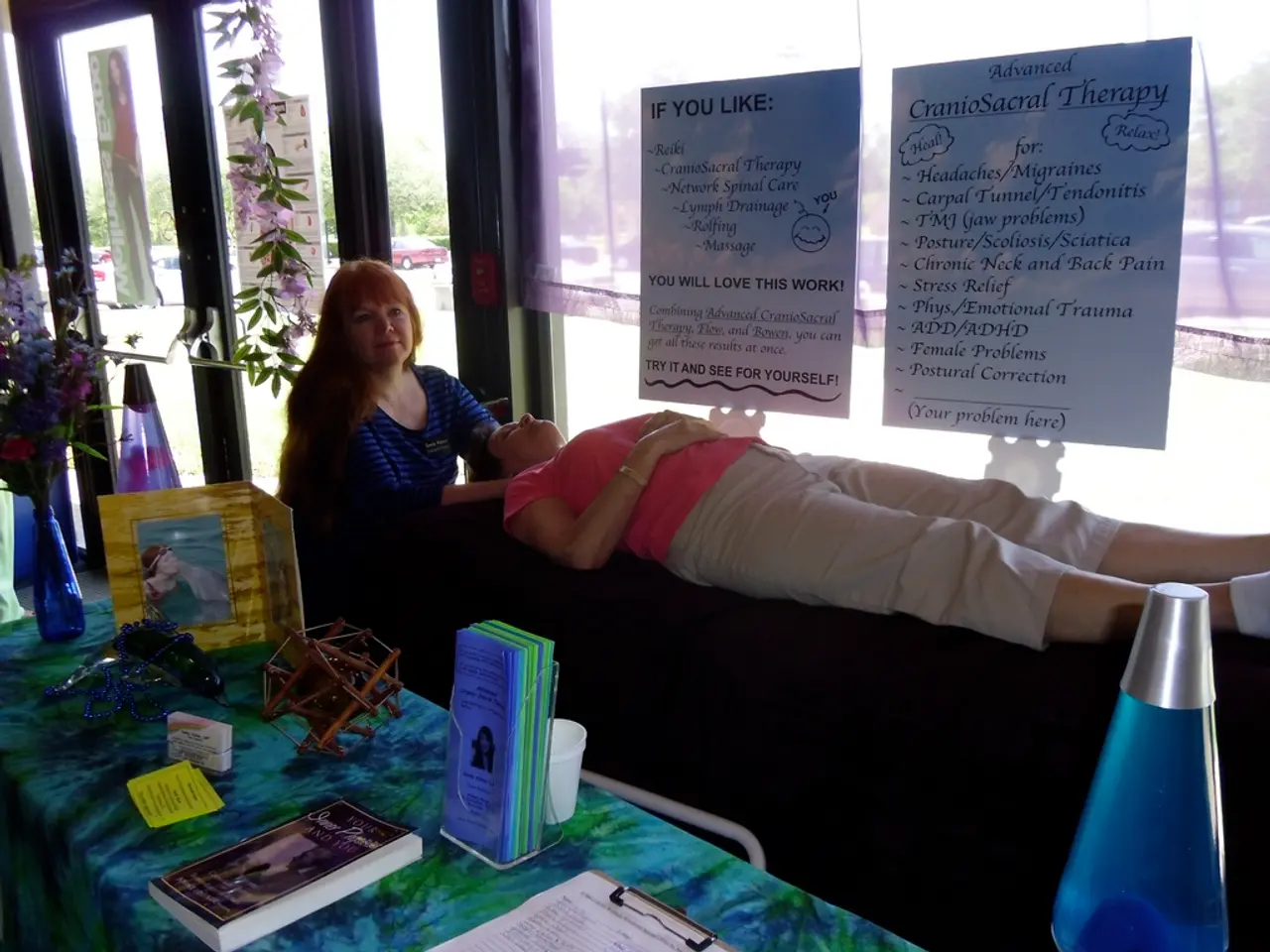Strategies for Overcoming Seasonal Mood Disorders: Exploring Four Methods to Alter Your Weather-Influenced Emotional State
Seasonal Affective Disorder (SAD), a type of depression that typically occurs during the fall and winter months, is characterised by persistent low mood, lack of motivation, irritability, difficulty focusing, fatigue, increased sleep and appetite, and a sense of sadness coinciding with seasonal changes [4][5].
To effectively manage SAD symptoms, a combination of approaches is recommended.
Light Therapy
Sitting near a 10,000 lux light box for about 20-30 minutes each morning during darker months can simulate natural sunlight, helping regulate circadian rhythms and improve mood [1][3][5]. This treatment is most effective when started 2-4 weeks before symptoms typically begin and used consistently every day.
Medication
Selective serotonin reuptake inhibitors (SSRIs) are commonly prescribed antidepressants for moderate to severe SAD. They help increase serotonin in the brain but require medical supervision due to possible side effects and delayed onset of action (usually 4–6 weeks) [1][3].
Psychotherapy
Cognitive Behavioral Therapy tailored for SAD (CBT-SAD) helps individuals recognise and change negative thought patterns, encouraging healthy routines, social engagement, and increased outdoor activity [1][3].
Lifestyle Adjustments
Maintaining a consistent sleep schedule supports circadian rhythm stability. Regular physical exercise, outdoor time when possible, social interaction, and relaxation techniques such as mindfulness or deep breathing can alleviate stress and improve mood [1][2][4].
Vitamin D and Diet
Addressing vitamin D deficiency through supplements and consuming foods rich in vitamin D (fatty fish, fortified foods, eggs) may support mood improvement, especially in seniors [1].
Sleep Hygiene
Limiting artificial light in the two hours before bedtime prevents circadian rhythm disruption, as evening light exposure can delay sleep onset and worsen SAD symptoms [5].
Tracking symptoms with a mood journal can help identify patterns and triggers, aiding in timely management and effective communication with healthcare providers [2].
For best outcomes, an individualised treatment plan developed with healthcare professionals and early intervention before symptom onset are advised [1][3].
In addition to these strategies, maintaining social connections is vital for managing seasonal depression, as social support and engagement can reduce the impact of SAD on individuals. Exercise releases the feel-good brain chemical serotonin, which can help counteract the feelings of low energy and sadness that often accompany seasonal depression. A healthy routine that includes regular exercise, a balanced diet, and adequate sleep can also help manage SAD [1].
Light therapy, meditation, and lifestyle adjustments are practical and accessible ways to prepare for and mitigate the symptoms of seasonal depression. However, it is essential to consult with healthcare professionals for personalised treatment plans and early intervention.
References:
[1] American Family Physician (2020) Common Questions and Answers about Seasonal Affective Disorder.
[2] Zauderer, Ganzer (2015) Seasonal affective disorder: an overview. Mental Health Practice.
[3] American Family Physician (2012) Seasonal Affective Disorder.
[4] Levitan (2007) Chronobiology and neurobiology of winter seasonal affective disorder. Dialogues in Clinical Neuroscience.
[5] American Journal of Psychiatry (2015) A 2015 randomized trial of Cognitive-Behavioral Therapy Versus Light Therapy for Seasonal Affective Disorder.
[6] Cochrane Database of Systematic Reviews (2019) Psychological therapies for preventing seasonal affective disorder.
[7] Depression Research and Treatment (2015) Seasonal Affective Disorder: An Overview of Assessment and Treatment Approaches.
[8] Scandinavian Journal of Medicine & Science in Sports (2011) An examination of serotonin and psychological variables in the relationship between exercise and mental health.
[9] Sleep-Wake Neurobiology and Pharmacology (2018) Advances of Melatonin-Based Therapies in the Treatment of Disturbed Sleep and Mood.
[10] Neuropsychiatric Disease and Treatment (2020) Healthy Eating, Physical Activity, and Sleep Hygiene as the Winning Triad for Sustaining Physical and Mental Health in Patients at Risk for or with Neuropsychiatric Disorders.
[11] Psychotherapy and Psychosomatics (2020) Efficacy of Light Therapy in the Treatment of Seasonal Affective Disorder.
[12] Psychology Today (n.d.) Symptoms of SAD.
[13] Biological Rhythm Research (2009) Seasonal affective disorder and exercise treatment.
[14] Sleep (2009) Effects of exercise on sleep and daytime sleepiness.
[15] Dialogues in Clinical Neuroscience (2007) The Neurobiology of Seasonal Affective Disorder.
[16] Archives of Psychiatric Nursing (2015) The Effects of Dietary Tryptophan on Affective Disorders.
[17] Sleep (2009) The effects of light on sleep and circadian rhythms.
[18] Dialogues in Clinical Neuroscience (2007) The Neurobiology of Seasonal Affective Disorder.
[19] Sleep-Wake Neurobiology and Pharmacology (2018) Advances of Melatonin-Based Therapies in the Treatment of Disturbed Sleep and Mood.
- Science has shown that CBD may support mental health due to its interaction with the endocannabinoid system, which plays a crucial role in regulating various physiological processes, including mood [9].
- Incorporating fitness-and-exercise routines into one's health-and-wellness plan can help alleviate symptoms of seasonal affective disorder by boosting mood and counteracting feelings of low energy [13].
- Certain therapies-and-treatments, such as talk therapy and mindfulness-based stress reduction, can help individuals cope with the emotional challenges associated with SAD and improve overall mental health [16].
- Ensuring balanced nutrition, particularly with foods rich in essential fatty acids, B vitamins, and minerals like magnesium, can contribute to better mood support and help combat feelings of sadness and irritability during SAD [10].




